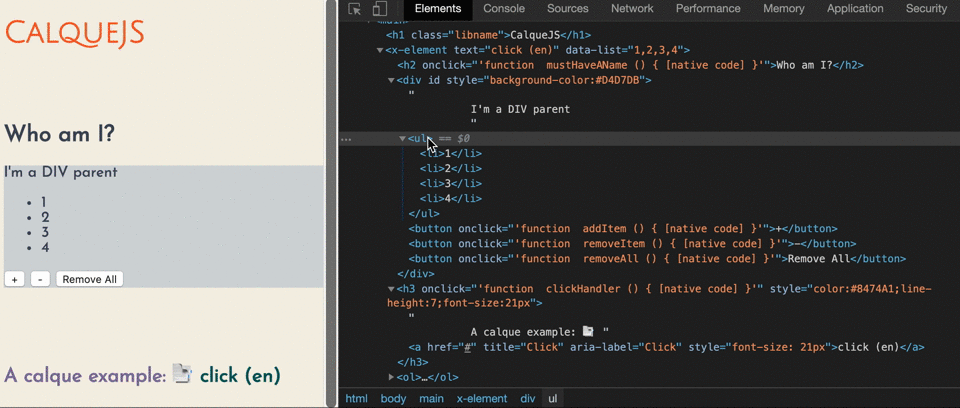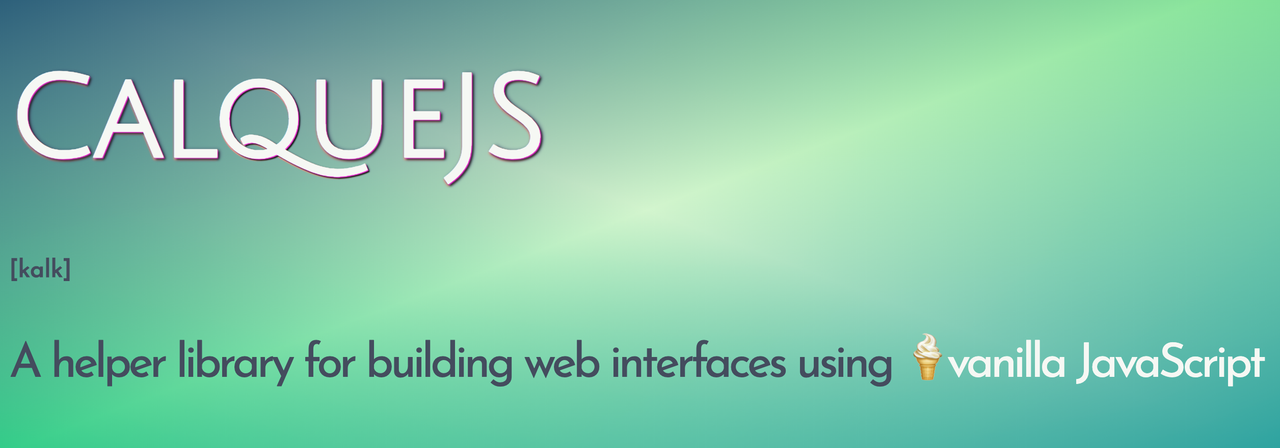README
calque.js 📑
CalqueJS is a tiny helper library (only ~7KB) for the native web platform, aimed to help building interfaces easily. The goal is to offer a declarative way to code UI components by writing bits of HTML, rather the traditional client-side scripting, and also providing a simple layer as Virtual DOM to update the view 🖼️ changes.
It is based only on Web Standards, 💪powered by JavaScript language, DOM & browser APIs, using them to calque the HTML-like template content into the base element properties. This approach suits to aid as an add-on for reusable Web Components. No dependencies, frameworks, or transpilation needed \o/ #usetheplatform
Install via:
NPM (Terminal)
$ npm install --save calque
Build components with a light abstraction
Custom Elements v1 using ES6
import { innerHTML, html } from '../dist/calque.mjs';
window.customElements.define('my-component', class extends HTMLElement {
static get observedAttributes() { return ['text', 'data-list'];}
constructor(...args) {
super(...args);
}
attributeChangedCallback() { this.render(); }
connectedCallback() { this.render(); }
showNodeName() {
alert(this.nodeName);
this.setAttribute('name', 'Neo name');
}
render() {
const colorProp = 'color';
const name = this.getAttribute('name');
this[innerHTML] = html`
<p onblur="${(e)=>console.log(e.target.textContent)}"
contenteditable>
Temporary text
</p>
<h3 onclick="${this.showNodeName.bind(this)}"
style="${
{
[colorProp]: "red",
"font-size": name.length+"em"
}
}">
Hello, λ ${name}
</h3>
<div>
<ul>
${
this.hasAttribute('data-list')
&& this.getAttribute('data-list').split(',').map(num => html`<li>${num}</li>`)
}
</ul>
<button onclick="${
(function removeItem() {
if (this.hasAttribute('data-list')) {
let list = this.getAttribute('data-list');
let lastIndex = list.lastIndexOf(',');
this.setAttribute('data-list', list.slice(0, lastIndex));
} else {
console.warn('No data-list attribute found');
}
}).bind(this)
}">-</button>
</div>
`;
}
});
Or for Web Component using ES5
import {innerHTML, html} from '../calque.mjs';
function NeoTag() {
console.log(this.constructor);
this.count = 0;
return Reflect.construct(HTMLElement, [], this.constructor);
}
NeoTag.prototype = Object.create(HTMLElement.prototype);
NeoTag.prototype.constructor = NeoTag;
Object.setPrototypeOf(NeoTag, HTMLElement);
NeoTag.prototype.handlerClick = function click(){
console.log('clicked', this);
};
NeoTag.prototype.connectedCallback = function() {
this.handlerClick = this.handlerClick.bind(this);
this[innerHTML] = html`
<p onclick="${this.handlerClick}">Neo Tag</p>
`;
};
customElements.define('neo-tag', NeoTag);
document.body.appendChild(document.createElement('neo-tag'));
A delightful VDOM-like approach
CalqueJS updates the DOM nodes after the changes on component attributes to reflect the new values.

⚠️ Warning: The component built using CalqueJS it's intended to be concise and reflect the template content, with that said, the component DOM tree shouldn't be modified via DOM API (removing or adding new nodes).
Features
🔧The motivation for CalqueJS comes basically inspired for what JSX represents for React, I must say that it's very boring to use React without JSX, because it simplify the coding of a React component using a common HTML grammar.
With the advent of Web Components, it's now possible to achieve some features provide by frameworks and libraries, but using the timeless advantage of the native web. The component pattern is one of the major benefit of Web Components, which enables to break the UI into distinct and small chunks of code providing a modular and reusable component to be used in many different contexts.
Simplify web interface implementation.
Nothing new or needed to learned, the mantra is 🙏: no 3rd party library API to interact, just some conveniences. Using CalqueJS is as easy as use template tags. This feature was added at ES6 as he Template literals, which are simply functions that allows to create domain-specific languages (DSLs). For more details about The HTML templating, access the book ExploringJS by Dr. Axel Rauschmayer.
Some subtle differences and gotchas
When using the library, pay attention for this details mentioned below:
- Adding Event Listeners smoothly: use function reference
onevent="myFunction", not function invocationonevent="myFunction()". Note that in HTML, event listener names are written only in lowercase, such as onclick, onmouseover, etc. In some libraries, however, like JSX or lit-html, event listener names are written in camelCase or with the prefix @, such as onClick or @click, respectively. The philosophy behind CalqueJS is to avoid at the most any divergence from common HTML syntax. - Passing inline CSS properties not only through strings, but by literal objects too: when using styling objects, the JSON-based format is mandatory. for example, you can pass a JSON object for the style attribute as
{[myProp]: "7px", "border-color": myValue}. OBS: single properties names will work{color: "blue"}but are better to follow the standard rules. - Avoid use the innerHTML property directly. In JavaScript, you can use a variable value to access the respective property name (
var f='foo',o={foo:'bar'}; o[f] // outputs "bar"), so instead of usedocument.body.innerHTMLordocument.body["innerHTML"], you must import and use theinnerHTMLvariable from CalqueJS, and them calldocument.body[innerHTML]together with thehtmltagged template function provided (html method is primarily a convenience function, and it can be especially useful when manipulating callback events). - Follow the best practices, we use double quotes for attributes values.
Just for curiosity, 🤔 In linguistics, a calque /kælk/ or loan-translation is a borrowing of a compound word from another language where each component is translated into native words and then joined together.
This definition, resumes the idea behind CalqueJS, (1) avoid some boilerplate code and (2) maximize the readability using the markup lingua franca for the web, as the same time, it enhance the component by bootstrapping his content.
Code Example
Use Serve as recommended Web Server, run:
$ npm i serve
Roadmap 🎯
There's quite a few things to be done:
- Attributes (not observed) updating
- Apply some code refactors (more functional programming style)
- Investigating Shadow DOM support
License
Code licensed under the MIT License.
🚧 Status: In Development 🛠️
☑️ Suitable for web UI prototyping 👌
☢️ use at your own risk ☣️
Some cool resources
https://github.com/w3c/webcomponents/
https://www.w3.org/wiki/WebComponents/
https://w3c.github.io/webcomponents/
https://developers.google.com/web/fundamentals/web-components/customelements
https://developer.mozilla.org/en-US/docs/Web/Web_Components/Using_custom_elements
